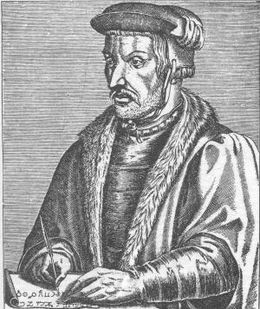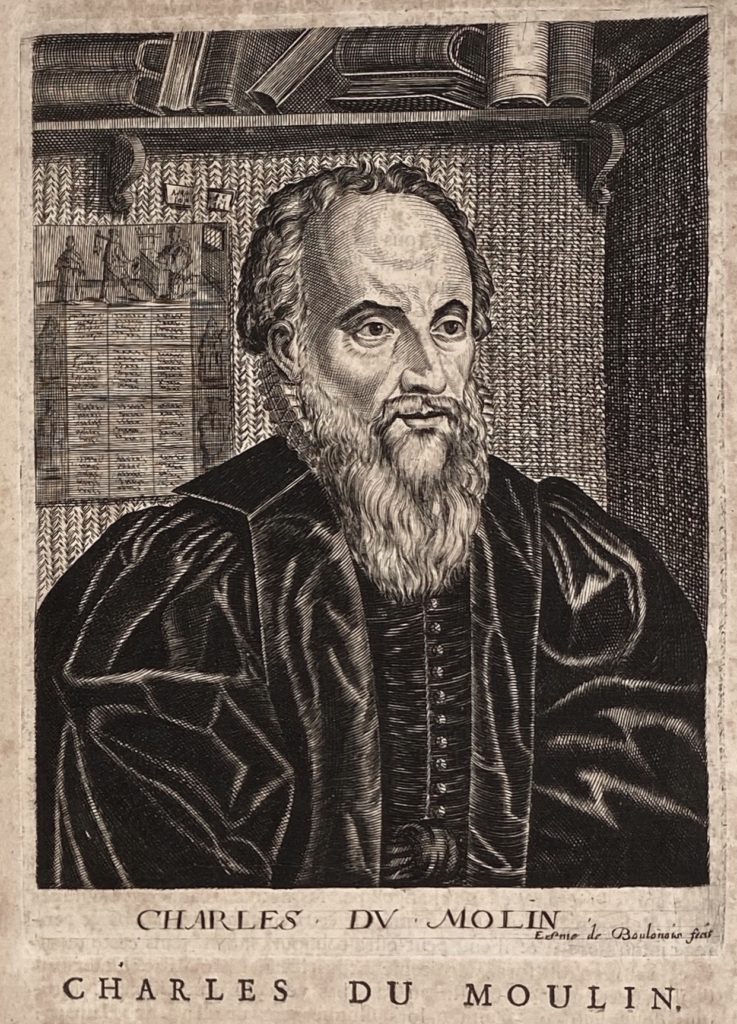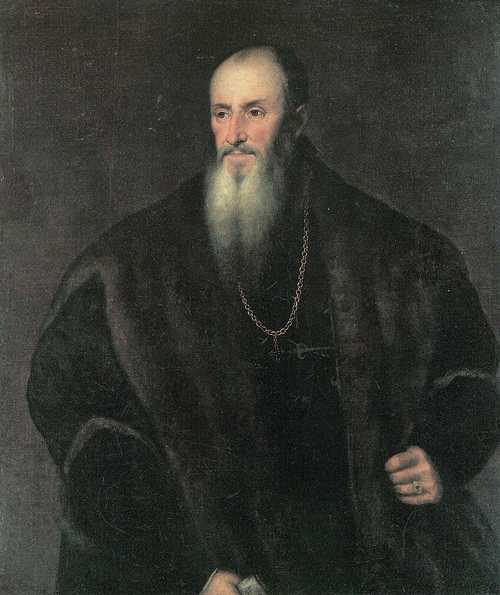There were many great professors and students that made the university renowned for the quality of its teachings. Some of them are well known, and some others left few to no traces except in the texts of the university itself, but they all participated in the greatness of the university of Franche-Comté. Here are some of them.
Pierre Le Fèvre said Pierre Fabri
Pierre Le Fèvre, known as Pierre Fabri, born in Rouen around 1450 and died around 1535, was a French metrician, rhetorician and poet. Pierre Fabri is one of the first authors who gave precepts on the art of writing in French[1]. He gave a singular Treatise on Rhetoric, divided into two books, printed in Gothic characters in Rouen by Thomas Ryer and Simon Gruel, 1521, in-8°. The second book of this treatise is completely devoted to poetic art and contains several pieces such royal songs, ballads, roundels, virelais, songs, etc. composed by him and cited as models for all genres of poetry. This work was very successful in its novelty and reissued several times from 1521 to 1544. We also owe him the les Épitaphes du roi Louys, printed in Rouen and Traité touchant le temps de maintenant, où sont introduites parlant ensemble douze dames, lesquelles sont : Rome, Florence, Gênes, Venise, Milan, France, Espagne, Angleterre, Flandre, Autriche, where the author himself fulfills the role of actor. He was briefly one of the teachers of the university of Dole in the years 1530, during which he participated in a renewal of the ruined institution alongside others at the start of the 16th century.[3]
- [1]LEBRETON Théodore-Éloi, Biographie rouennaise, Rouen, Le Brument, 1865, p. 134
- [2]AGRIPPA Henri-Corneille, Expostulatio super expositione sua in librum ‘De verbo mirifico’, in Opera, Cassel, après 1605, t. II
- [3]BEAUNE, H., & D’ARBAUMONT, J. (1870). Les Universités de Franche-Comté : Gray, Dole, Besançon: documents inédits publiés avec une introduction historique. J. Marchand
- [4]MARCHANDISSE Alain, MASSON Christophe, « Les tribulations du Grand Bâtard Antoine de Bourgogne en Italie (1475) », dans : Publications du Centre européen d’Etudes bourguignonnes (XIVe-XVIe siècles) [titre : Rencontres de Romes (25 au 27 septembre 2008). Bourguignons en Italie, Italiens dans les pays bourguignons ; XIVe – XVIe s.), vol. 49, 2009, p. 23-49
Cornelius Aggrippa

Henri-Corneille Agrippa of Nettesheim, known as Corneille or Cornelius Agrippa, is considered an esoteric scientist, representative of a skeptical conception of magic: “natural magic”. He was born in Cologne on September 14, 1486. He studied literature in 1502, probably medicine, law, theology: he was “doctor of literature and doctor of medicine from Cologne-sur-le-Rhin”. He then traveled throughout Europe (France, Spain, England, Germany, Italy, and Switzerland) as a soldier, doctor and teacher. In honor of Marguerite of Bourgogne, he wrote a treatise in Latin entitled De la noblesse et préexcellence du sex feminine (written in 1509 but published in 1529). He founded an association of friends in Avignon and Paris, including Charles of Bovelles and Jacques Lefèvre d’Étaples, who practiced alchemy. In England, he frequented the great humanist scholars, including John Colet. In 1509, he taught Johannes Reuchlin’s Christian Kabbalah in Dole[2], which led him to be accused of heresy. His presence as a teacher in Besançon, despite being ephemeral, also participated in the renewal of the ruined institution at the start of the 16th century.[3]
Guillaume de Rochefort
Guillaume de Rochefort (1433 [rather 1439]-1492) was doctor of laws and decree, a chancellor of France under Louis XI and Charles VIII. He was the son of Jacques II and Agnès de Clérona, and lord of Rochefort, Pleuvaut and Longeaua. Probably a native of the region of Rochefort (in the Jura), he was first in the service of the Dukes of Burgundy Philippe le Bon and Charles le Téméraire as ordinary councilor then chamberlain of Burgundy[1]. In particular he moved away in 1474, by dint of money, the Swiss and the Germans ready to invade the county of Burgundy. Likewise, he was ambassador to Italy to the pope and other princes in that country. However, he had to abandon his court and lost his possessions. After the death of the duke in 1477, he accepted the offers of Louis XI, entered his Council and was appointed first government of Blaisoie and finally chancellor of France on May 12, 1483 by letters from the king. The king also returned to him the lands of Pleuvaut and Longeau, confiscated from his father Jacques II de Rocheforta. He presided over the Estates General of Tours in 1484, and was later charged with laying down the bases of the treaty under which Charles VIII married Anne of Brittany. He is the older brother of Guy de Rochefort, who was also Chancellor of France. His marking act at the destination of the university of Dole, where he made his studies, was to press Charles VIII into giving back their privilege and university that has been retired by Louis XI.[4]

Charles Dumoulin

Charles Dumoulin, born in Paris in 1500, died in 1566 is a French jurisconsult who taught in Dole between 1555 and 1556. He was known for his positions in favour of Gallicanism (organization of a church in France on the Anglican model). He also marked his opposition to Calvinism, denouncing its authoritarian drift. At the end of his life, he declared himself a Lutheran. Charles Dumoulin descended from a noble family, allied to Anne Boleyn, mother of Queen Elizabeth I of England. He was received as a lawyer in the Parliament of Paris in 1522 but, having been unable to overcome a stutter to which he was subject, he retired from the bar and devoted himself to the work of the cabinet. Observations on the edict of Henri II relating to small dates , which he published in 1551 and where he maintained that the king had the right to repress the abuses and frauds which were committed in Rome in the distribution of benefices, earned him the good graces of Henry II, but gave rise to lively complaints from the Holy See. His work was condemned by the Sorbonne in May 1552. A follower of the Reformation, Dumoulin had embraced Calvinism. Worried about his opinions, he was forced to take refuge in Germany, where he was received with the greatest distinction. After having taught at the University of Dole in 1555 and 1556, he returned to Paris in 1557, but it was to undergo new tribulations there. He was also rejected by the Protestant Church after opposing Jean Morély, and the system of governance imposed by Geneva. Dumoulin denounced the authoritarian ecclesiastical system of Calvinism (theocracy) which he considered worse than the Catholic Church. He also criticized his rigor and the fact that the pastors sent to France were foreigners. Charles Dumoulin was the first to find the true sources of French law and laid down the fundamental rules: he commented on the principal customs of France; his Révision de la Coutume de Paris is considered a masterpiece. The best edition of his works according to the Bouillet Dictionary is that of Paris, 1681, 5 folio volumes.
Nicolas Perrenot de Granvelle
Nicolas Perrenot de Granvelle, born in 1486 in Ornans (then in the County of Burgundy) and died on August 27, 1550 in Augsburg, was in the 16th century, Chancellor and Keeper of the Seals of the Holy Empire, first adviser and man of confidence in France. Comtois of Emperor Charles V, Sovereign Count of Burgundy and Suzerain of the Imperial City of Besançon. Nicolas is the son of Pierre Perrenot (died in 1537), notary in Ornans, and Étiennette Philibert (died in 1540 ), descended from the local gentry. His father sent him to the University of Dole, then capital of the county of Burgundy, to study law. In 1518, he became a lawyer and was appointed at the age of 34 as a councilor in the parliament of the county of Burgundy. The Emperor Charles V is himself Count of Burgundy by inheritance of the title of his grandmother, the Duchess and Countess Marie de Bourgogne. In 1518, he became a lawyer and was appointed at the age of 34 as a councilor in the parliament of the county of Burgundy. Charles V was elected emperor at the age of 19. Nicolas Perrenot de Granvelle quickly became his very close confidant, the Emperor nicknamed him his “bed of rest”. He is made chancellor, which will contribute to him acquiring an immense family fortune and giving him all the powers, in the name of the emperor, in the county of Burgundy. His sons and sons-in-law (the Granvelle family) occupied the best places in the county and at the imperial court. He had the Granvelle Palace built in Besançon. A great lover of works of art and precious books, he gathered in his palaces a prestigious collection which was increased by his son, the cardinal and politician Antoine Perrenot de Granvelle (1517-1586). In 1532, he became Keeper of the Seals of Charles V at the age of 48. In 1534-1547, his status and his fortune allowed him to build his own palace in the main street in Besançon, the sumptuous Granvelle palace which introduced Renaissance architecture to the city. This palace (today the Musée du Temps de Besançon) became the symbol of his prodigious power, success, fortune, prestige, personal and family social ascension.
